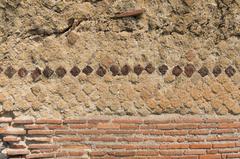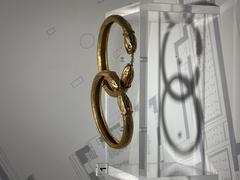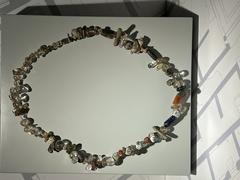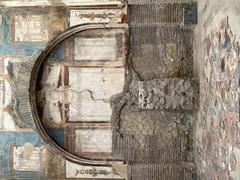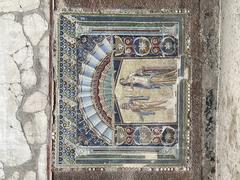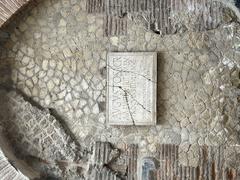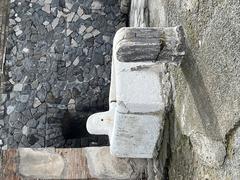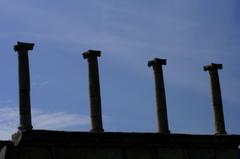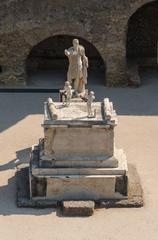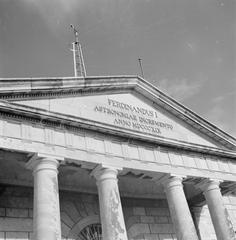
Comprehensive Guide to Visiting Herculaneum
Date: 13/08/2024
A Riveting Journey into Herculaneum: Unveiling Hidden Wonders
Imagine strolling through a city where time has stood still, where luxurious villas and bustling streets vividly recall the golden age of Rome. Welcome to Herculaneum, a seaside town once the playground of Roman aristocrats, now a well-preserved archaeological wonder. This ancient marvel was frozen in time by the catastrophic eruption of Mount Vesuvius in 79 CE, providing a unique, intimate glimpse into the daily lives of its inhabitants (Britannica). Legend has it that Herculaneum was founded by the Greek hero Heracles, known to the Romans as Hercules, adding a mythical charm to its historical allure (Wikipedia). From the fertile volcanic soil that nurtured its prosperity to the luxurious villas adorned with intricate frescoes and stunning mosaics, Herculaneum offers a sensory journey back in time. As you explore this time capsule, imagine the sounds of chariot wheels and the chatter of merchants in the bustling marketplace. Get ready to uncover not just the grand structures but also the hidden gems, quirky local customs, and the everyday life of a town that thrived before it was engulfed by volcanic ash (World History Encyclopedia).
Navigate Your Adventure: What’s Inside
- Historical Background of Herculaneum
- A Journey Back in Time
- The Mythical Beginnings
- The Samnite and Roman Hands
- The Roman Golden Age
- Digging Deeper: Hidden Gems and Local Secrets
- Sensory Immersion
- Interactive Elements
- Cultural Context and Etiquette
- Practical Tips with a Twist
- Pop Culture References
- Themed Itineraries
- Local Lingo Lessons
- Seasonal Highlights
- Myth Busting and Surprises
- Storytelling Elements
- FAQ
- Call to Action
- Significance of Herculaneum
- A Time Capsule of Roman Life
- Rediscovering Herculaneum
- Exceptional Preservation
- Daily Life and Social Structures
- A Glimpse Into the Economy
- Health and Human Remains
- Religious Life
- Archaeological Innovations
- UNESCO World Heritage Site
- Visiting Herculaneum
- Tips for Your Visit
- Conclusion
- Visitor Tips
- Welcome to Herculaneum: A Journey Back in Time
- Best Times to Visit
- Ticketing and Entry
- Duration of Visit
- Seasonal Considerations
- Accessibility and Facilities
- Maps and Guides
- Highlights and Must-See Attractions
- Additional Tips
- Insider Secrets and Hidden Gems
Historical Background of Herculaneum
A Journey Back in Time
Welcome to Herculaneum, an ancient seaside resort where Roman aristocrats reveled in luxury, surrounded by stunning villas and breathtaking views of the Gulf of Naples. Imagine walking through a town frozen in time by the catastrophic eruption of Mount Vesuvius in 79 CE. Intrigued? Let’s dive into the rich history of this ancient marvel.
The Mythical Beginnings
Legend has it that Herculaneum was founded by none other than the Greek hero Heracles—yes, Hercules in Roman lingo (Wikipedia). However, historians credit the Oscans, an Italic tribe, with establishing the first settlement (World History). The town changed hands frequently, from the Etruscans to the Greeks, who named it Heraklion and turned it into a bustling trading post near the Gulf of Naples (Wikipedia).
The Samnite and Roman Hands
By the 4th century BCE, the Samnites, another Italic tribe, had taken over, and the town thrived as a coastal pit stop between Neapolis (modern Naples) and Pompeii (World History). The fertile volcanic soil and abundant tuff stone for building made it a prime location. When Herculaneum fell into Roman hands around 89 BCE, following the Social War, it was like winning the architectural lottery. The city walls from the 2nd century BCE became part of homes and buildings, including the House of the Inn (Wikipedia).
The Roman Golden Age
Herculaneum morphed into a swanky seaside resort where Rome’s elite came to play. Imagine villas adorned with colorful marble, intricate frescoes, and stunning mosaics (Britannica). The Villa of the Papyri, a treasure trove of papyrus scrolls, and the eerie stillness that followed the eruption are just a few of the town’s fascinating features.
Digging Deeper: Hidden Gems and Local Secrets
Beyond the grand villas, there are hidden gems like the ancient thermopolium (a Roman snack bar) where you can almost smell the aroma of ancient Roman delicacies. Wander through the lesser-known alleyways and discover quirky local customs or the remnants of daily life frozen in time.
Sensory Immersion
Picture the sound of waves crashing against the shore, the smell of the salty sea air, and the tactile sensation of ancient stone under your fingertips. As you explore, listen for the echoes of chariot wheels and the chatter of merchants in the marketplace.
Interactive Elements
Why not turn your visit into a treasure hunt? Seek out specific artifacts like the famous bronze statues or the intricate mosaics depicting mythological scenes. Challenge yourself to find the best photo spots or recreate ancient recipes using ingredients from the local market.
Cultural Context and Etiquette
While exploring, keep in mind the local customs and social norms that shaped Herculaneum. For instance, the Romans had a knack for elaborate greetings and a strong sense of community. Embrace these customs and you’ll connect more deeply with the history around you.
Practical Tips with a Twist
Need some practical advice? Take a cue from Roman poets and remember: “When in Herculaneum, do as the Romans do.” Wear comfortable sandals, carry a water flask (ancient style), and don’t forget your sunhat—just like a true Roman aristocrat.
Pop Culture References
Fans of historical dramas will be thrilled to know that Herculaneum has inspired scenes in movies like “Pompeii” and books such as Robert Harris’s “Pompeii.” These pop culture nods add an extra layer of excitement to your visit.
Themed Itineraries
Embark on a themed journey through Herculaneum. Whether you’re interested in architecture, daily Roman life, or the dramatic events of the eruption, there’s an itinerary just for you. Choose your own adventure and uncover the secrets of this ancient town.
Local Lingo Lessons
Brush up on some key phrases in Latin or Italian to enhance your experience. Try phrases like “Salve!” (Hello!) or “Gratias tibi ago” (Thank you). You’ll impress the locals and feel more immersed in the culture.
Seasonal Highlights
Herculaneum offers unique experiences throughout the year. In the spring, the town comes alive with blooming flowers, while summer brings vibrant festivals. Each season has its own charm, so plan your visit accordingly.
Myth Busting and Surprises
Think you know everything about Herculaneum? Think again! Did you know that the town had an extensive water system that rivaled modern plumbing? Or that some buildings had heated floors? These surprising facts add depth to your exploration.
Storytelling Elements
Dive into short, engaging stories about Herculaneum’s past. Learn about the dramatic escape of a local family during the eruption or the daily routines of a Roman merchant. These narratives bring history to life.
FAQ
Q: How long should I plan to spend in Herculaneum? A: A full day allows you to explore the main sites and hidden gems at a leisurely pace.
Q: Is Herculaneum suitable for families? A: Absolutely! Kids will love the interactive elements and the chance to step back in time.
Q: What’s the best time of year to visit? A: Spring and fall offer pleasant weather and fewer crowds.
Call to Action
Ready to explore Herculaneum? Unlock the city’s secrets and stories with the Audiala app. Download it before your visit for beautifully crafted, concise yet deep audio guides that will enhance your exploration experience. Dive into the history and culture of Herculaneum like never before!
Significance of Herculaneum
A Time Capsule of Roman Life
Imagine a seaside town frozen in time, where you can stroll through ancient streets, peek into luxurious villas, and even see remnants of meals that were never finished. Welcome to Herculaneum, a gem of ancient Roman civilization buried under a blanket of volcanic material when Mount Vesuvius erupted in 79 AD (Wikipedia). Unlike its more famous neighbor, Pompeii, Herculaneum was preserved in a way that offers an extraordinary glimpse into Roman life, complete with wooden buildings and everyday items (World History Encyclopedia).
Rediscovering Herculaneum
The tale of Herculaneum’s rediscovery is as thrilling as a treasure hunt. In 1709, a farmer digging a well struck gold—well, more accurately, he struck an ancient theatre (History Skills). This accidental find led to systematic excavations starting in 1738 under King Charles of Bourbon. From treasure hunts to scientific digs, the journey to uncover Herculaneum has been a fascinating one. Today, efforts focus more on preserving what’s already been unearthed rather than exposing more (Wikipedia).
Exceptional Preservation
What makes Herculaneum stand out? Its preservation is nothing short of miraculous. The volcanic material turned to stone, protecting multi-storeyed buildings, frescoes, papyri, and even food (World History Encyclopedia). This preservation offers invaluable insights into daily Roman life. For instance, the Villa of the Papyri was a luxurious residence with a vast collection of carbonized scrolls that modern technology is helping to read (History Skills).
Daily Life and Social Structures
Walking through Herculaneum is like stepping back in time. The town was a retreat for the Roman elite, as seen in the lavish homes adorned with colored marble (Wikipedia). The House of the Stags, for example, is a sprawling, luxurious residence with ornate frescoes and intricate mosaics (History Skills). On the other hand, smaller homes and apartment buildings give us a peek into the lives of ordinary folks.
A Glimpse Into the Economy
Herculaneum was more than just a pretty face; it had a thriving economy. Shops like bakeries with intact ovens and mills, and thermopolia (ancient fast-food joints) with terracotta jars, give us clues about the town’s commerce and culinary practices (History Skills).
Health and Human Remains
One of the more poignant discoveries at Herculaneum is the human remains. Over 300 skeletons were found in beachfront warehouses, likely where people sought refuge from the eruption (History Skills). Studies of these remains, including DNA analysis, provide insights into the people’s health, diet, and demographics. For example, their good dental health suggests a diet low in sugar.
Religious Life
Religion played a central role in Roman society, and Herculaneum is no exception. Temples, shrines, and religious artifacts found in homes reveal the spiritual practices and diverse pantheon of gods worshipped by the Romans (History Skills).
Archaeological Innovations
The excavation of Herculaneum has significantly advanced archaeological methods. Technologies like multi-spectral imaging are being used to decipher carbonized scrolls, offering unique insights into Roman literary and philosophical life (History Skills).
UNESCO World Heritage Site
In 1997, Herculaneum, along with Pompeii and Torre Annunziata, was declared a UNESCO World Heritage site (Britannica). This honor underscores the importance of preserving these cultural and historical treasures for future generations.
Visiting Herculaneum
Visiting Herculaneum is like taking a step back in time. Unlike Pompeii, it’s quieter and less crowded, making it easier to explore at your own pace (Nomad Epicureans). The site is open daily, with tickets priced at €13 for adults and €2 for reduced tickets (Along Dusty Roads). Audio guides are available for €10, or you can join a guided tour for deeper insights (My Flying Leap).
Tips for Your Visit
For the best experience, bring a hat, sunscreen, and a water bottle, especially in summer (Nomad Epicureans). Only small bags are allowed inside, but you can store larger items for free at the cloakroom. Consider visiting on weekdays to avoid the crowds (Nomad Epicureans).
Conclusion
Herculaneum’s incredible preservation and rich history make it a must-visit for anyone interested in ancient Rome. The site offers a unique glimpse into Roman life, from luxurious villas to bustling shops. And before you go, don’t forget to download the Audiala app. It offers beautifully crafted audio guides that reveal the secrets and stories of Herculaneum, making your visit even more enriching and memorable.
Visitor Tips for Herculaneum
Welcome to Herculaneum: A Journey Back in Time
Imagine stepping into a time capsule, where the echoes of ancient footsteps and the whispers of a bygone era greet you. Welcome to Herculaneum, a city frozen in time since AD 79. This guide will not only help you navigate this stunning archaeological site but also sprinkle in some humor, hidden gems, and engaging stories to make your visit truly memorable.
Best Times to Visit
For a serene experience, arrive at Herculaneum early in the morning or late in the afternoon. Early birds catch the shortest ticket queues and the calmest atmosphere. Night owls, visit two hours before closing and witness the site as it magically empties (European Traveler). Avoid the first Sunday of each month—free admission means crowds that could rival a Roman gladiator match!
Ticketing and Entry
Get your tickets onsite for the best deal, but skip-the-line benefits are worth considering if you book online or join a group tour (European Traveler). The Campania Arte Card, available as a mobile app, not only saves you money but also offers priority entry. Be sure to book your free timeslot in advance (European Traveler).
Duration of Visit
Unlike its sprawling cousin Pompeii, Herculaneum’s compact size means you can explore thoroughly in two to three hours (Naples Wise). Guided tours rarely exceed two hours and involve much less walking. Think of it as Pompeii’s less strenuous little sibling (European Traveler).
Seasonal Considerations
April to October is peak season. If you prefer fewer crowds and cooler weather, visit during the off-season. Summer visitors should prepare for heat that could make even a Roman soldier sweat. Hats, sunblock, and water are your best friends (Mia’s Travel Memoirs).
Accessibility and Facilities
Herculaneum is more manageable than Pompeii, with shaded areas that offer respite from the sun (European Traveler). Food and drink options are limited, and once you leave the modern paved area, water and toilets are scarce (European Traveler).
Maps and Guides
Don’t miss the map and information booklet at the entrance. They often run out, so a downloaded map or a good guidebook is a smart backup. The official map and guide are available on the Herculaneum website.
Highlights and Must-See Attractions
Herculaneum is a treasure trove of ancient wonders. Here are the must-see spots:
- Casa dell’Albergo (Inn): A patrician house turned inn, offering a glimpse into ancient Roman hospitality (PlanetWare).
- House of Galba: Famous for its unique cross-shaped pool in the peristyle (PlanetWare).
- Thermae (Baths): Well-preserved thermal baths with intricate mosaics (PlanetWare).
- Samnite House: One of the oldest mansions, featuring dramatic frescoes and a Greek-style atrium (PlanetWare).
- House of the Deer: A luxurious villa with stunning frescoes and a grand garden (PlanetWare).
- House of the Relief of Telephus: Known for its spacious colonnaded atrium and marble basin (PlanetWare).
- Sacello degli Augustali: A shrine dedicated to Hercules, later consecrated to the Imperial cult (PlanetWare).
- The Fornici: Port warehouses where 300 people sought refuge during the eruption—an eerie yet fascinating spot (PlanetWare).
Additional Tips
- Comfortable Footwear: The ancient streets of Herculaneum are uneven, so sturdy walking shoes are a must (Mia’s Travel Memoirs).
- Check for Closures: Not all areas are always open due to ongoing excavations. Check the official website to avoid disappointment (Naples Wise).
- Guided Tours: While self-exploration is easy, a guide can offer insights that bring the ruins to life (European Traveler).
- National Archeological Museum of Naples (MANN): Complement your visit with a trip to MANN, home to many artifacts from Herculaneum (Naples Wise).
Insider Secrets and Hidden Gems
- Local Lingo: Impress locals with a few Italian phrases. Say “Buongiorno” (Good morning) and “Grazie” (Thank you) as you explore.
- Hidden Corners: Venture off the main paths to discover lesser-known spots like the House of the Bicentenary, recently reopened to the public.
- Myth Busting: Contrary to popular belief, Herculaneum wasn’t a sleepy backwater; it was a thriving, affluent town before the eruption.
Seasonal Highlights
Each season offers unique experiences in Herculaneum. Spring brings blooming flowers, summer offers extended daylight hours, fall showcases vibrant foliage, and winter provides a peaceful, almost mystical atmosphere.
Call to Action
Ready to uncover the secrets of Herculaneum? Download Audiala, the tour guide app that turns your visit into an unforgettable adventure. With beautifully crafted, concise audio guides, Audiala reveals the hidden stories and fascinating history of this ancient city. Get Audiala now and start your journey back in time!
By following these tips, you’ll enjoy a memorable and hassle-free experience at Herculaneum, exploring the rich history and well-preserved ruins of this ancient Roman town.
Unlock Herculaneum with Audiala: Your Perfect Travel Companion
Herculaneum stands as a testament to the grandeur and intricacies of ancient Roman life, offering an unparalleled window into the past. Its extraordinary preservation allows us to walk through history, from lavish villas to bustling shops, and even uncover personal artifacts that tell the stories of its inhabitants. Unlike its more famous neighbor, Pompeii, Herculaneum offers a quieter, more intimate experience, making it a must-visit for anyone intrigued by ancient civilizations (Nomad Epicureans). Its archaeological significance is underscored by its designation as a UNESCO World Heritage site, a recognition of its invaluable contribution to our understanding of Roman society (Britannica). Whether you’re an archaeology enthusiast, a history buff, or simply a curious traveler, Herculaneum invites you to explore its streets, marvel at its art, and immerse yourself in its rich cultural tapestry. Before you embark on this journey, don’t forget to download the Audiala app, your perfect companion for uncovering the secrets and stories of this ancient city. With expertly crafted audio guides, Audiala will enhance your exploration, making your visit to Herculaneum even more enriching and memorable.
Where We Found the Magic: References
- Herculaneum, 2023, World History Encyclopedia source url
- Herculaneum, 2023, Wikipedia source url
- Herculaneum, 2023, Britannica source url
- Herculaneum, 2023, History Skills source url
- Tips on Buying Tickets and Visiting Herculaneum, 2023, European Traveler source url
- Visit Herculaneum, 2023, Nomad Epicureans source url
- Herculaneum, 2023, Naples Wise source url
- Pompeii and Herculaneum in One Day, 2023, Mia’s Travel Memoirs source url
- Visit Herculaneum Ruins, Italy, 2023, Along Dusty Roads source url
- Herculaneum Ruins, 2023, My Flying Leap source url
- Tourist Attractions, 2023, PlanetWare source url
